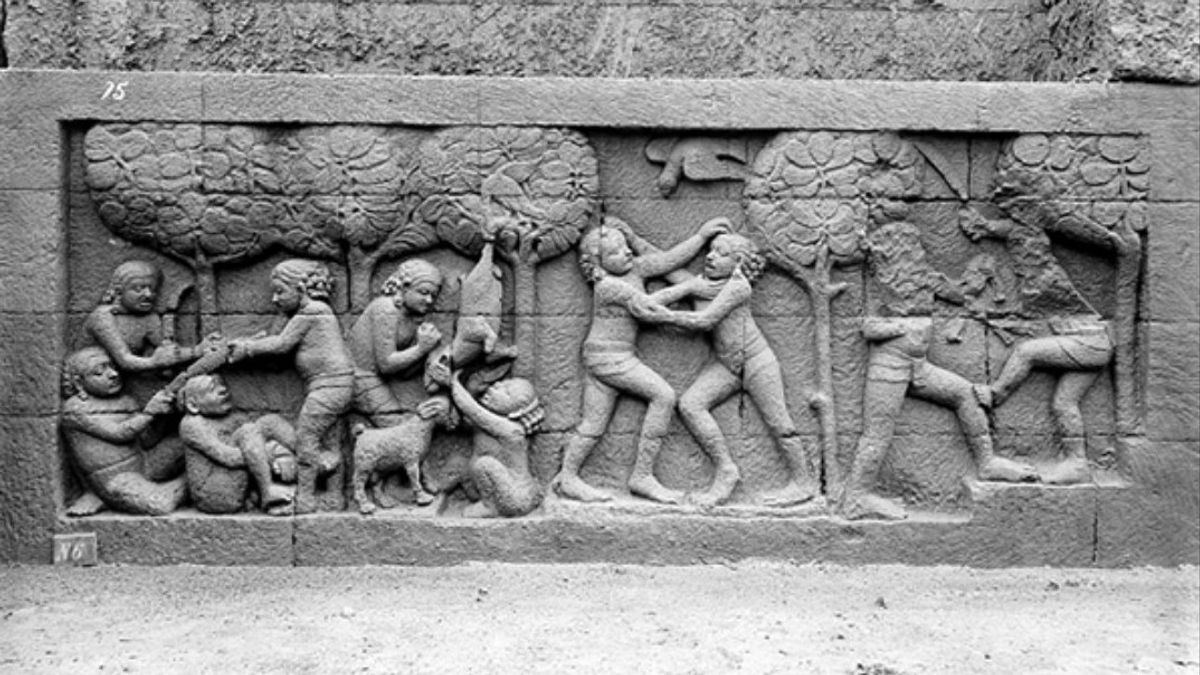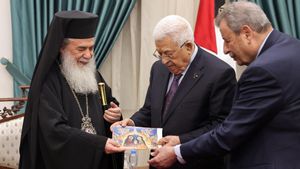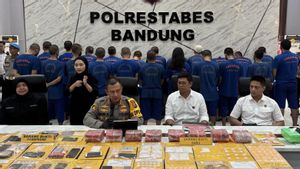JAKARTA - There is an allusion to a serious tendency when the word thuggery is mentioned. He grows up as a trait that tends to be annoying, close to violence and abuse. However, on the other hand, thuggery is born out of oppression itself. They are usually thugs who escape from the distribution of welfare.
In a certain period of time - during the New Order era (Orba) - for example, thugs were synonymous with sloppy styles. He looked cruel, his hair was long, his whole body was decorated with tattoos. It sounds stereotypical. Unfortunately for the tattoos and long hairs because they seem to be born with this bad stigma.
Tjamboek Berdoeri's book, Memoar Kwee Thiam Tjing explains the origin of the word preman which comes from the Dutch word "vrije man" which means free people. Interestingly, there is not the slightest bad connotation of the word vrije man when it was born in the colonial era of the Dutch East Indies. The word actually refers to people who are free from the shackles of state employees, soldiers who are free from a colony, non-contracted coolies or freelancers who are paid daily.
Meanwhile, acts of violence similar to thuggery today have occurred for hundreds of years. This can be seen through ancient inscription data. Quoted from the book produced by the 4th Scientific Meeting of Archeology in Cipanas on March 3-9, 1986, epigraphist Boechari describes the world of thuggery and bandits in ancient Javanese society as happened during the kingdoms of Sriwijaya, Kediri, Singosari and Majapahit.
The inscription notes
This is known through archaeological studies in the form of inscriptions, palm leaves or ancient manuscripts. As for the depiction in several temple reliefs, it can be seen in Mendut Temple, Surawana Temple and Rimbi Temple. In the ancient Javanese era, criminal acts where the punishment were not only the perpetrators, but also the community in the area where the crime occurred. It can take the form of fines and burdensome taxes. For this reason, the community has set up security posts to minimize crime that will affect the entire region.
As written on the Baliwangan inscription dating from 891 AD. This inscription contains the law of determining the land in the village of Baliwangan as Sima (Daerah Perdikan). The inscription also contains information on how the people there have to pay taxes and fines because of the rah kasawur - splattered blood - due to criminal acts and wankay kabunan - the dewy corpse - which was found as a result of a criminal incident in another village and then his body was dumped in Baliwangan Village. Even though it is only a crime scene (TKP), Baliwangan Village is still subject to taxes and fines.
Meanwhile, in the Mantyasih inscription dating back to 907 AD, it is told how the people of Mantyasih Village felt afraid due to the actions of criminals and they were unable to overcome it. Finally, the Raja Rakai Watukura Dyah Balitung area had to intervene to deploy troops and five patih to combat criminal acts in the village of Mantyasih which is located around Mount Sumbing, Central Java.
In the Kaladi inscription in 909 AD, the request of Dapunta Suddara and Dapunta Dampi told Raja Rakai Watukura Dyah Balitung so that their area around the Arapan Forest could become a safe area. This is because they are always under attack from criminals which makes the traders and fishermen in the village feel scared.
Another story is told in the S unemployment inscription from 928 AD which was found in Malang. In addition to containing curses for people who commit crimes, this inscription also contains several actions that often occurred at that time and were classified as criminal acts at that time, such as wipati wankai kabunan (discovery of corpses), rah kasawur (bloodshed), wakcapala ( cursing), duhilatan (accusing), hidu kasirat (spitting on people), hastacapala (hitting with hands), mijilakan turuh nin kikir (pulls out sharp weapons), mamuk (goes berserk), mamp bait (acts of violence against women), ludan (fights ), tutan (chasing a losing opponent), danda kudanda (hitting), bhandihaladi (evil using magical powers).
Further information is also contained in the ancient manuscript, namely the Purwadhigama script, which originates from the ancient Mataram period, to be precise during the reign of King Dharmawangsa in 991-1016 AD. This book was compiled to regulate public order in the ancient Mataram Kingdom. In this text is written the ancient court system which divides all kinds of criminal and civil acts into 18 types of crimes. Although the 18 laws were not many, the outline of things that were considered important at that time were already written, such as Tan kashuranin pihutan (not paying debts), tankawahanin putawawa (not paying security deposits), adwal tan drwya (selling goods that did not belong to him). ), tan kaduman ulihin kinabehan (not sharing the results of cooperation), karuddhanin huwus winehakan (asking back what has been given).
Other laws that are recorded are tan kawehaninupahan (no wage or reward), adwa rin samaya (breaking a promise), alarambaknyan pamalinya (restriction of sale and purchase transactions), wiwandanin pinanwakenmwan manwan (dispute between livestock owners and herders), kahacu panin watas (boundary dispute - land boundaries), dandanin saharasa wakparusya (law for acts of insulting and cursing), pawrtinin malin (theft), acts of sahasa (acts of violence), unlan tan yogya rin stri (inappropriate actions against a husband and wife), kadumanin drwya (distribution inheritance), totohan pranidan totohan tan prani (betting and gambling).
Images of violence and thuggery can also be seen in several temples, which contain reliefs as information. As stated in the Buddhist Mendut Temple in Central Java. On the entrance stairs on the south side of the temple, a relic of the 9th century AD, there is a relief depicting two figures, the first one holding a machete, while the second holding a shield.
Likewise, at the Surawana Temple in Kediri, a relic of the 14th century AD, at the base of the temple, there are reliefs depicting scenes of violence and fighting. Meanwhile, at the Rimbi Temple in Jombang, dating from the 13th century AD, at the foot of the temple on the south side, there is a picture of two men fighting in the middle of the forest. The phenomenon of ancient Javanese society regarding the world of violence cannot be separated from the social, economic, and political conditions at that time.
The kings at that time also made rules and values of life so that people lived in harmony based on their beliefs or religions. To socialize the rules that have been made, inscriptions are made or depicted in temple reliefs. Even though it has been made to share the rules with all the harsh legal sanctions and the royal jurisdiction located in the villages has played an active role in maintaining order around their environment, but sometimes there were still acts of violence and crime in those days.
Colonial Age
Entering the colonial era of the Dutch East Indies, pereman or Vrijman, was seen as a defender for contract coolies who worked on plantations or factories owned by the Dutch government who were tortured by their foremen. Quoted from Kompas, November 30, 1986 edition, as a token of gratitude for the services of these thugs, the community at that time used them to take food and drinks from their stalls. It was from this phenomenon that the term vrij man changed to preman which was an acronym for "pre-drink pre-meal", pre shortened from prei, which comes from the word vrij.
During the independence era, thugs participated in efforts to defend independence and carried out revolutions. They were incorporated into warrior armies. In the 1950s, the term preman was still positive and even received appreciation from the government. In fact, as quoted from the writings of Martin Sitompul in an article on the Historia page, the Mayor of Medan, Haji Moeda Siregar - who served from 1954-1958 - once gave awards to thugs.
This was because at that time thugs were considered to have a role in helping the community and maintaining order. Preman reconcile the conflict between the Acehnese and the Batak tribes. Thugs also help to follow up on various complaints from the public who have experienced theft and robbery by finding the leaders of pickpockets and robbers around the scene of the incident so that the belongings of the person who complained were returned.
The English, Chinese, Japanese, Arabic, and French versions are automatically generated by the AI. So there may still be inaccuracies in translating, please always see Indonesian as our main language. (system supported by DigitalSiber.id)









